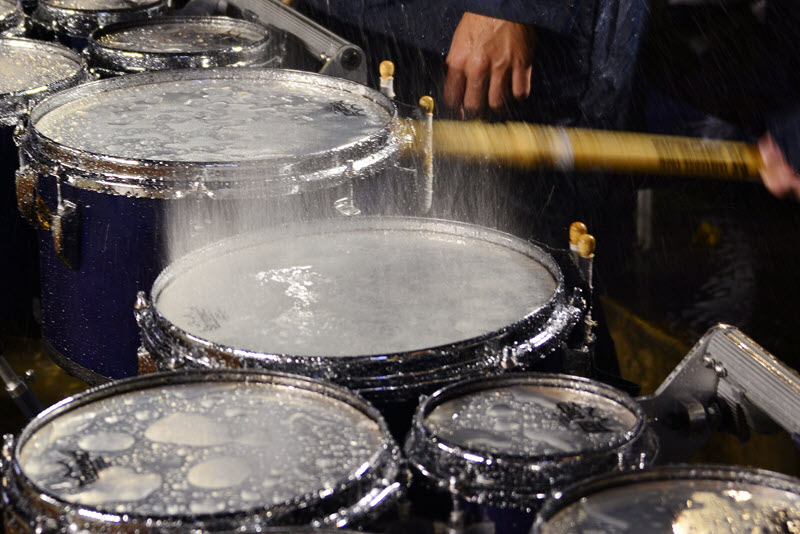Here’s What to Do When Your Marching Drums Get Wet
Avoiding disaster when the skies open up.
At some point during the school year, it’s likely that your high school or college drumline will get caught outside in the rain during a football game, a parade or a rehearsal. In this posting, we’ll tell you what to do when that happens.
Your marching band drums are made of wood and metal — two materials that water really loves to wreak havoc upon. If this happens, you will surely want to take the time to service your drumline in order to get those instruments ready to go before the next rehearsal or performance.
First, let’s review how to prepare for wet conditions … assuming you know that bad weather is on the way.
Be Prepared
The old Boy Scout motto is the way to go. Be sure you know the details of your playing environment wherever you will be performing or rehearsing. Ask yourself the following questions:
– Is there a chance of rain, snow or moisture of any kind?
– If it does rain, can the drumline take cover relatively fast?
– If we must play in the rain, what steps can we take to protect the instruments while playing?
– How soon can we get out of the rain after the event and how do we get them dry fast?
– What resources will we have to help dry the gear immediately?

Things To Do
1) Bring drum covers. They’ll help keep a good amount of the water off your gear while it is raining. Measures should still be taken after the rain has begun to ensure the drum is protected.
If playing in the rain is unavoidable, at least bring the covers and have them in a place where you can get to them quickly during the performance. Don’t leave the covers on an equipment truck — keep them in a place where you can get to them fast. Make sure you have the prop crew or a band booster group member standing by to quickly gather the covers and put them on the drums.
2) Bring towels. They’ll help you intermittently wipe down the drums while you are in the stands. Instructional staff should keep towels handy to wipe drums any chance you get.
3) Have people ready to help. This means staff, parents, friends, etc. — whomever is nearby. They need to be at the ready to get covers, find a place to take cover, hold the towels and do whatever else is needed.
4) Bring a pop-up tent just in case. This is great to use for indoor percussion competitions where you need to warm up and rehearse in the lot before the performance. Be sure to bring sand bags as well to hold the tent down. When it rains, it gets windy, so those sand bags are essential!

Playing in the Rain
Let’s say you get caught and did not prepare. Do not fear! If you take some very simple steps, your drums will survive the downpour.
1) Prep your players for the steps they’ll need to take. After the performance, don’t let your drumline members take off without helping to clean and dry the drums. Let them know your plan to get the drums dry and cleaned up before everyone leaves. The first and most important step is to get those drums dry right away.
2) Dry the drums. Take all the heads off and use a dry towel to wipe down all the drums, inside and out. If there’s a hair dryer handy, use it to speed up the process. If the school has large, oversize floor fans, put them next to the drums and turn them on full blast. Let the air circulate inside and around the drums at least overnight.
3) Don’t put wet or damp drums in a case. This could be your biggest mistake! By putting wet or even slightly damp drums in their cases you run the risk of ruining your gear. Your hardware could rust and your shells could be soaked. The latter is a big deal because the wet shells could begin to pull apart, leading to warping of the shells or allowing mold and mildew to set in.
If you can, discourage your band director from scrambling everyone to “hurry up, get the drums in the cases and get on the bus.” If you don’t have time to fully dry the drums before putting them in their cases for traveling — for example, if you have to quickly load them on a truck to get out of the rain — at least wipe the drums down to get off as much water as possible, then do a more thorough job as soon as you get back to the band room, the hotel or your next rest stop.
4) Put it all back together. Once you know everything is dry, be sure to:
a. Inspect all the drums and wipe down the heads again really well.
b. Put the heads and hardware back on the drums.
c. Replace the grease on the tension rods.
d. Put the gravity guards back on to the bottom side of your snare drums.
e. Put all the drums back in their cases.
Young drummers tend to not take as good care of their drums as, say, a trombone player would of their trombone. As an instructor, you have a duty to make sure your kids take good care of their gear. It all starts with you to help them understand how and what to do. And don’t forget the parents: your band boosters are equally responsible to help protect the gear.
Always remind yourself and your students that marching percussion instruments are first and foremost musical instruments. Like anything else in life, the better you take care of what you have, the longer it will last.
Photos by MMB Photography
This article was originally published on the Yamaha Educator Suite blog.















